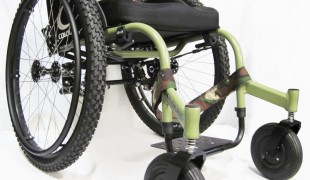- 4018
- 338
- 4
- 6
- 0
- Help Ukraine
About the solution
The wheelchair, called “Ogo”, is based on Segway technology, utilizing balance to control the movement of the hands-free wheelchair, which enables the user to move intuitively, more precisely and hands-free.
“The disabled are exactly like you and me, they all need freedom and excitement in their life. And Ogo takes that to a whole new level. It will go faster, it will go more places and is smaller and lighter than just about anything else. And the fact that you can operate it completely hands-free makes Ogo a definite game-changer”, said the inventor.
With special features, like being able to change tyres to allow users to travel in all terrains, the wheelchair can move up to 20km per hour even off-road.
There is currently one prototype in existence. The Ogo has been under development since 2011 and is currently in the preproduction stage, but Kevin expects the wheelchair to be available to the public soon, with investment backing.
Users simply lean in the direction of travel and use their core muscles even to stay in balance which occupational therapists say is a key benefit of the Ogo.
Its hands-free design will enable users freedom to do more from playing sports to mowing the lawn.
“It’s one of the life affirming things that this machine does, it puts you in touch with your whole body again,” Mr Thompson said.
In its first version, Mr Halsall borrowed a Segway and added a bolt-on seat. But he wanted to refine the steering further, so he bought his own Segway, which he stripped down, and then patented a new seat moving control mechanism, which he installed.
The wheelchair also has stabilisers for when users are working or lifting items off the floor. The battery-powered device can also be steered manually if necessary.
The Ogo has been tested on people with disabilities from T4 to T12 and some tetraplegics. Anyone with abdominal control can operate the device hands free.
Those without abdominal control can still use the chair by holding on to its sides.
The wheelchair also has stabilizers for when users are working or lifting items off the floor. The battery-powered wheelchair can also be steered manually.
A price for the Ogo is yet to be fixed but Mr Halsall says he wants to keep it as low as he can to "make it affordable to people that need it".
Adapted from: http://bit.ly/1LDYrgB
More info: http://khalsall.com/
https://www.youtube.com/watch?v=zgat4a1TrEM
This solution shall not include mention to the use of drugs, chemicals or biologicals (including food); invasive devices; offensive, commercial or inherently dangerous content. This solution was not medically validated. Proceed with caution! If you have any doubts, please consult with a health professional.
DISCLAIMER: This story was written by someone who is not the author of the solution, therefore please be advised that, although it was written with the utmost respect for the innovation and the innovator, there can be some incorrect statements. If you find any errors please contact the patient Innovation team via info@patient-innovation.com
-
-
247
-
0
-
2722

Collaborator James Leckey makes equipment to improve the quality of life and social inclusion of children with special needs
MOVING IN A WHEELCHAIR: Moving using a wheelchair.
BODY BALANCE: Maintaining body balance
STANDING UP: Standing up from a seated position
Playing
Neuromuscular Disorders
Assistive Daily Life Device (to help ADL)
Walking Aid (wheelchair/walker/crutches)
Assistive Technology access
5 Senses support devices: (glasses, hearing aids, headphones...)
Restoring mobility
Promoting self-management
Managing Neurological Disorders
Promoting inclusivity and social integration
Maintaining Balance and Mobility
Raise awareness
General and Family Medicine
Neurology
Orthopedics
Pediatrics
Physical Medicine and Rehabilitation
United States
-
-
-
488
-
0
-
7159

Paralyzed man invents customized and light weight wheelchairs
MOVING IN A WHEELCHAIR: Moving using a wheelchair.
Paralysis
Spinal Cord and Nerve Root Disorders
Cerebral Palsy
Cervical spinal cord injury/Tetraplegia
Walking Aid (wheelchair/walker/crutches)
Difficulty coordinating movements
Paralysis of the legs and lower body
Muscle weakness
Restoring mobility
Promoting self-management
Managing Neurological Disorders
Promoting inclusivity and social integration
Maintaining Balance and Mobility
Neurology
Orthopedics
United States
-
-
-
573
-
0
-
9513

Wheelchair Accessible Recliner
MOVING IN A WHEELCHAIR: Moving using a wheelchair.
CAREGIVING
Cervical spinal cord injury/Tetraplegia
Walking Aid (wheelchair/walker/crutches)
Managing pain
Promoting self-management
Preserving Organ Function
Promoting inclusivity and social integration
Maintaining Balance and Mobility
Restoring Blood Circulation
Preventing (Vaccination, Protection, Falls, Research/Mapping)
Internal Medicine
Neurology
Orthopedics
Rheumatology
United States
-
 en
en